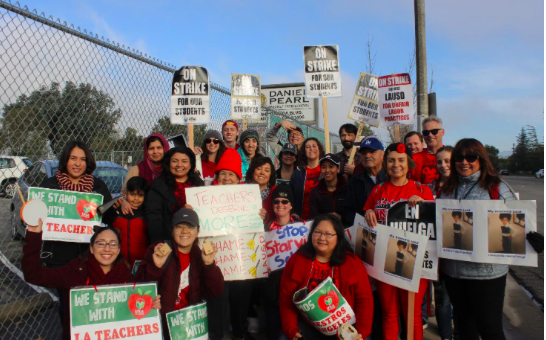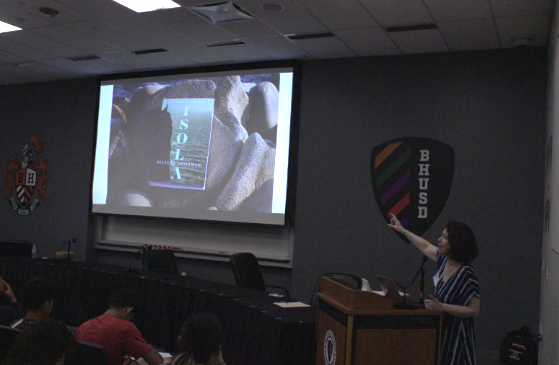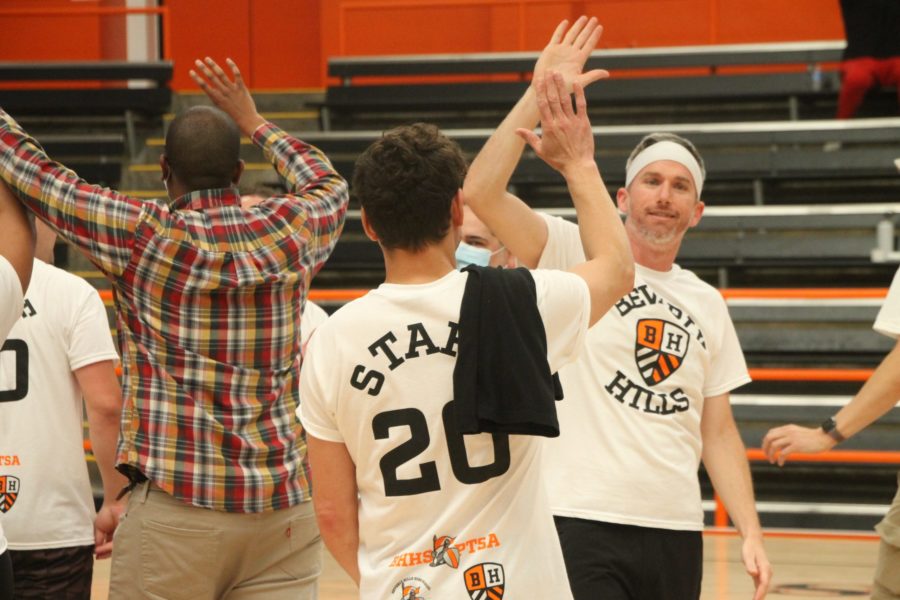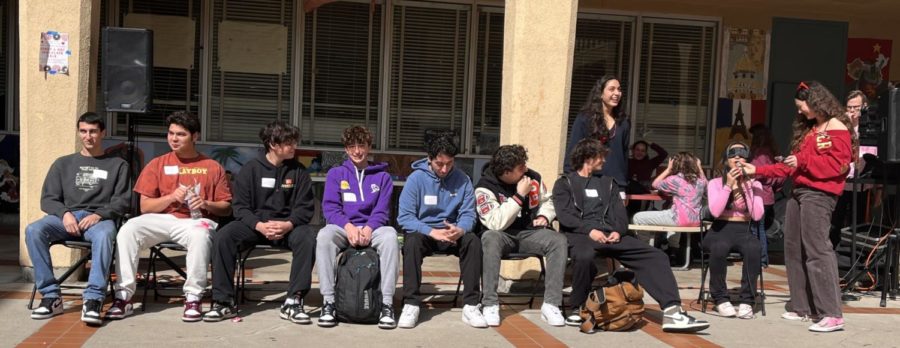Mikaela Rabizadeh media editor
Ava Seccuro staff writer
The strike that recently transpired between the Los Angeles Unified School District (LAUSD) and the United Teachers Los Angeles (UTLA) was reminiscent of the contract negotiations earlier this school year in BHUSD. When LAUSD students and families stood alongside their teachers, it gave students and faculty on our own turf a chance to reflect on how our school community can learn from our neighboring district.
UTLA began their strike on Jan. 10 and picketed until Jan. 16. On Jan. 22, they reached a tentative agreement with LAUSD stating that both organizations will jointly advocate for higher county and state funding in schools, student reductions in classes to comply with class size caps, a charter school cap, a 3 percent salary increase for teachers and efforts to hire more counselors, nurses and librarians.
The Beverly Perspective
During contract negotiations, senior Adriel Ghadoushi voiced his support for the teachers during the public comment segment of the of the Aug. 28 board meeting. As one of the many students affected by the work-to-contract job action, he encouraged the board and teachers union (BHEA) “to come together and find a solution for the sake of the whole district.” When UTLA began their strike, Ghadoushi found many similarities between the two labor disputes.
“The UTLA strike definitely hit close to home in almost every aspect. You had the district administration repeating the same lines that there is no money for a significant salary increase nor for the demands that the teachers made, as we had at BHUSD,” Ghadoushi said. “What was especially interesting with the UTLA strike is that the teachers had the backing of their community and especially with the parents.”
However, he thinks that during LAUSD’s and BHUSD’s respective labor disputes, both school communities formed a stronger bond while fighting for something that would benefit the entire school community.
“Obviously any strike or work-to-contract hurts community morale, but when you have a district, whether it be BHUSD or LAUSD, villainize the teacher’s union it really affects the student-teacher dynamic,” Ghadoushi said. “As weird as it may seem, labor disputes at school districts usually bring us all closer together because we can appreciate the hardworking and dedicated educators offer students, but also how little they get rewarded for that work…The same went for parents and students at LAUSD who striked side by side with their teachers for something that didn’t just help teachers pay their bills, but benefited the community as a whole.”
Chemistry teacher and BHEA union grievance chair Chris Bushee notices very few similarities between BHUSD and LAUSD labor disputes, because BHUSD had already been given a slight and gradual salary increase; therefore, they were never close to voting for a strike.
“Certainly nobody overtly [in BHUSD] was mentioning the word strike. We were very upset. There were times when we thought that it was going to be very difficult to find agreement, but I think [in] both parties, [there was] a willingness to compromise and find a middle ground that helped us,” Bushee said. “I think that we started out with positions that were closer to each other that made it easier for us to find an agreement…[In] LAUSD, they really started out very far apart from where they needed to be, so it ended up escalating to the level of a strike.”
Despite the differences between the labor disputes, Bushee and the rest of BHEA wanted to show solidarity and sympathy for UTLA.
“UTLA’s color is red…So people all across the state [were wearing red] to be in solidarity. [BHEA] wanted to do it because they’re in our profession,” Bushee said. “They might not be the same district, but if conditions get worse in Los Angeles, then that can have a spillover effect and conditions can get worse other places. Everybody has an interest all around the state in making sure that the learning conditions for students and the teaching conditions for teachers are the best they can be.”
The LAUSD Perspective
Although UTLA wanted to avoid striking at all costs, a teacher at Daniel Pearl Magnet High School and UTLA member Adriana Chavira claims that teachers in UTLA had been fighting for certain items in the tentative agreement for so long, that they had to strike in order to gain the attention of the district.
“No one really wanted to be out of the classroom. I didn’t really think it was going to last six days, it lasted longer than I would’ve hoped, but I think it was time that teachers stood up for what they believed in and there were various things that the union wanted to achieve in this. It wasn’t just one single item or one single demand that they had,” Chavira said. “They had at least seven or eight demands that they wanted. They’ve been trying to work for those for several years and I think teachers were just at the breaking point and that’s how we ended up going on strike.”
Regarding such demands, University High School Charter junior Taadi Henderson emphatically agrees with the UTLA demand that requires more staff to be hired since LAUSD is so underfunded. One factor she thinks contributed to less funding toward the LAUSD is the fact that ex-LAUSD board president Refugio Rodriguez allegedly laundered $25,000 to fund his 2015 board election campaign, to which he pled guilty for in July 2018.
“The purpose is to show the district and the state that we need more funding for our schools, and we need more because obviously our superintendent, as some of you may know, never had experience in a classroom,” Henderson said. “Some may have heard that our ex-[board-member] had laundered $25,000 that could have gone to us. All of our schools are underfunded and since there’s so many of us, we need the funding for our schools. We need to hire more teachers, school nurses, special aids. We need to hire like practically more of everything.”
For Los Angeles Center for Enriched Studies (LACES) junior Zack Monterosso, the similarities between his school, a magnet school, and University High School Charter are striking. Both are in dire need of more staffers, and as Monterosso recalls, the school nurse at LACES is only on duty on Monday, Wednesday and every other Friday.
“My school is not bad. We were okay, but a lot of LAUSD schools have massive classes, [and now] we have pretty big classes too. A lot of classes are more than 35 kids, some are over 40,” Monterosso said. “We also have a nurse only [two days] out of the week, which is really weird… It’s just really strange cuts like that, that aren’t like acceptable to education.”
Although demands for more staffers were a primary component in the proposed agreement compiled by UTLA, Chavira explains that among the seven to eight demands that UTLA wanted the district to consider, putting a cap on charter school recruitment to save declining LAUSD enrollment was one that would benefit Daniel Pearl Magnet the most.
“As far as reasons, one of the big ones was some issues that we’ve been facing at our school: competition with charter schools. They’ve been, for the past 10 years, targeting students from LAUSD to try to get them to go to their campuses. So, our enrollment has been going down. Overall, LAUSD has lost enrollment in the past decade,” Chavira said. “My school [is a] small school, and we also have been seeing that competition between the kids go[ing] to charters or coming to our school. Often, they’re choosing to go to a charter school…One of the things that the union was fighting for in the contract was to have the district limit the number of charter schools that they approved and to encourage more oversight of charter schools as well.”
At first, Monterosso was hesitant to fully support the strikes due to the amount of school he might miss, but as the reasons on why UTLA voted to strike became clearer, he realized that he was not only fighting for his education, but for all of LAUSD’s.
“I think that at first I was a little bit worried about how the strike would affect me because like, personally for me, I’m taking five AP classes. It’s like the worst year for me to have this because it’s, you know, it’s my junior year, this is important. I was scared that I’d miss a lot of school. At first, I was worried about it and didn’t think it was that important,” Monterosso said. “But…right when I started protesting with people on the first day, I realized that that was kind of selfish for me to not fully support it at first because this isn’t just for my education, it’s for the education of everyone younger than me. Everyone at other schools who have it lot worse than me.”
The Aftermath
The tentative agreement that was reached a week ago did not meet all of the demands of UTLA, as Chavira puts it. Like BHUSD, a compromise had to be negotiated and out of it came district reassurance over healthcare payments, but smaller class sizes are not yet reinforced at all grade levels.
“I don’t think all of [the demands were met]. I think that there had to be some sort of compromise. The salary amount was a bit less than we expected, but they did achieve appointing that our district pays for health care for our teachers and retirees, and the district has been wanting to get rid of that,” Chavira said. “As part of this compromise, the district said, ‘Okay, we’re not going to touch healthcare. You guys can continue to have it, including retirees.’ I think that’s something good that benefits the teachers. Some of the classroom class size issues in some schools and grade levels is good, [but] it wasn’t achieved in elementary or special ed.”
A prominent factor in the strikes, which according to Monterosso, did the most to not only help UTLA and LAUSD reach an agreement, but also to highlight similar issues in other counties, was the state-wide attention that LAUSD gained from the media due to its size and influence.
“Though the deal wasn’t perfect, the class sizes are still pretty big and the counselor to student ratio isn’t that different, we definitely need a really big step in improving our school systems which I think is really good,” Monterosso said. “One of the most important things, which most school districts or maybe even any other school district couldn’t do because LAUSD is massive, is we got a whole lot of attention from the state.”
Henderson believes that although the deal made between UTLA and LAUSD was a start toward progression in the district, the strikes could have been avoided altogether if only the district had been more sensitive to the needs of the students.
“I feel like [the strikes] did [help] slightly because the district obviously listened to us and our needs since they came to an agreement. It may be very little, but it was something,” Henderson said. “I think that we could have avoided the strike if we were listened to more and not looked at as if we were dollar signs rather than students who are trying to learn and trying to go to a higher level in our lives.”
As it’s been around five months since the BHUSD labor dispute, Bushee understands the negotiating process and offers his sympathies for the strike, but claims that UTLA will be the beneficiaries in the long run.
“I think it was important. It’s unfortunate that it had to reach a level of a strike. It’s unfortunate that in order for the school district to really take seriously the demands of the union, which really it was demands for better learning conditions for the students they teach. It’s unfortunate that teachers that go on and go out on a strike and lose over a week of pay because of that,” Bushee said. “But, that’s a one time loss for the students and the teachers. The gains are going to be enormous because the agreement that they signed, [will] lower class sizes, it’s going to bring in more services for students and ultimately the quality of education in LAUSD is going to go up. It’s a short term loss, but a long term gain.”
LAUSD strikes allow BHEA to reflect on past district negotiations
January 31, 2019

0
Donate to Highlights
$125
$1000
Contributed
Our Goal
Your donation will support the student journalists of Beverly Hills High School. Your contribution will allow us to purchase equipment and cover our annual website hosting costs.
More to Discover






































![Sophomores Jurnee Burrell-Williams and Bao Dang take cover during the lockdown (staged). “We both kind of didn’t know [what to think],” Dang said. “They usually send drill messages before.”](https://beverlyhighlights.com/wp-content/uploads/2023/02/E8D27FA0-AB24-4A26-9745-F7EEFF48FA93-900x736.jpeg)



